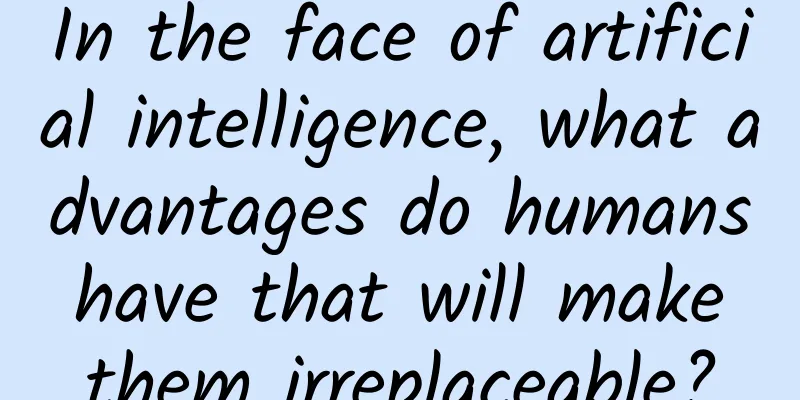In the face of artificial intelligence, what advantages do humans have that will make them irreplaceable?

|
Audit expert: Xu Runsheng PhD in Artificial Intelligence, University of California When it comes to artificial intelligence, the sci-fi scenes created in the movie "The Matrix" once shocked the world and set the trend. Based on the hypothesis of an American philosopher "brain in a vat", the movie describes the following background: humans who thought they were living in the late 20th century and early 21st century were actually bioenergy providers "raised" in the "cradle" by machines hundreds of years later, but humans who were "imprisoned" in the "cradle" "regained their freedom" in the world created by the artificial intelligence "Matrix". This makes us think about this question again: If your brain is controlled by a machine, transmitting various neural electrical signals to you and giving you feedback as before, can you discover it? Source: Internet Neurobehavioral patterns of the human brain The human nervous system consists of two parts: the central nervous system and the peripheral nervous system. The brain is the largest and most complex structure of the former, and it is also the most advanced part of the nervous system. Therefore, in various science fiction works, the brain is the most critical element. For example, in Liu Cixin's "The Three-Body Problem": In order to penetrate the Trisolarans and minimize the load mass, humans finally decided to send only the brain into space. Neurons are the most basic structural and functional units of the nervous system. To understand the human brain, we must understand neurons. Below we will focus on neurons and their working principles. Neurons are the core elements of neural behavior. There are more than 10 billion neurons in our brains. Studies have found that there is a significant positive correlation between the volume of gray matter (composed of neuronal cell bodies) and intelligence. Therefore, in people's general cognition, the more neurons a person has, the smarter he is. Source: Sohu News Neurons are made up of two parts: the cell body and the protrusions. The protrusions of different lengths carry different functions. The shorter dendrites are used to receive signals, and the longer axons are used to transmit signals. To put it another way: the dendrites are like the doors of neurons, and the axons are the hands that knock on the doors. When the neuron hears the knock on the door, it opens the door and gets the signal to act. If the neuron needs to pass information to others, it knocks on other people's doors. Each neuron has many doors and many hands, which means that each neuron is connected to many neurons. If you think about it, you will find how huge the neural network is. Just like when we chat, we like friends who reply immediately. When transmitting signals, neurons also like those who are quick to respond. Slow neurons will be gradually abandoned, making the neural network more agile and refined. (Perhaps this is why people believe that the more you use your brain, the smarter it is.) Source: Internet Principles of artificial intelligence Now that we understand how the human brain processes and transmits information, let’s take a look at the development history of artificial intelligence. The development of artificial intelligence has been full of twists and turns. The 1950s to 1980s was the era of symbolism. People tried to give computer systems logical reasoning capabilities by analyzing the way the human brain processes problems, but ultimately failed. In the following 20 years, expert systems became mainstream. People tried to summarize human knowledge and teach it to computer systems, but also suffered a Waterloo. Since the 21st century, the importance of data has gradually been recognized, and mining information from data has become a trend. Deep learning based on big data has achieved great success in the fields of speech and images. The speech-to-text and automatic translation that we are familiar with now are the initial major achievements of this stage. Source: Baidu Pictures As the core of current artificial intelligence, it is necessary for us to understand some basic content of deep learning. The predecessor of the deep learning model is the neural network, which also shows that the former imitates the brain's neural network to a certain extent. To illustrate this more vividly, we use the simplest linear regression model for analysis. For example, when we want to judge or predict the price of a house, we will think of many related factors. Here we choose two main factors: area and age. Let X1 represent the area of the house (square meters), X2 represents the age of the house (years), and y represents the price of the house (yuan). Linearity shows that the following formula is true: a1 and a2 are called weights, which determine the impact of each feature (area, house age) on the predicted value y. Assuming that we now have a lot of known house prices and corresponding house age and area data, we can use various methods (such as least squares method, etc.) to find a set of values for parameters a1, a2 and b. With this set of values, we can predict the prices of other houses. In this prediction process, the input is the size and age of the house, and the output is the predicted price. We can make an analogy with the structure of neurons, and regard X1 and X2 as two dendrites of the neuron cell body. After receiving these two pieces of information, the neuron processes them (calculates the value of y based on a1 and a2), and transmits the result through the axon. A neuron can include an input layer and an output layer. The complex neural networks in the human brain support us in a variety of activities. Multi-layer neural networks and other types of neural networks can help us solve many problems such as prediction and image recognition. Source: Baidu Pictures Next, I will introduce another case of discovering patterns through artificial intelligence. The human brain has limited knowledge storage, and the ability to analyze and utilize data is also limited. However, increasingly advanced hardware equipment ensures the storage and analysis of massive data, and can discover hidden patterns from it. For example, after analyzing the purchase data of supermarket goods, an American institution found that beer and baby diapers are often sold together. After analysis and investigation, it was found that this is a common combination for fathers to go out shopping on weekends. So the supermarket sold beer and diapers together, which is convenient for fathers and also increased sales. This is just the tip of the iceberg of AI data analysis. It can help us discover many connections hidden in the data, and we can benefit from it through analysis and understanding. What human behaviors cannot be simulated by artificial intelligence? With the vigorous development of artificial intelligence technology, the sci-fi imaginations that were once advanced in movies seem to be gradually becoming reality. The confrontation between the human brain and artificial intelligence is becoming more and more obvious, especially in the field of games that we are familiar with: Deep Blue (chess AI) and AlphaGo (Go AI) have achieved remarkable results in competition with humans. We can't help but ask ourselves, in what areas do humans have an advantage? The more we understand artificial intelligence based on big data, the more we recognize the digitization of human behavior. Imagine if there is a machine that records all personal information and social data, will there be a difference between humans and machines? Source: Screenshot from The Matrix It is difficult to give a definite answer to this question at present. Especially since the current hardware conditions cannot support such a huge amount of data, it is even more difficult to predict what will happen in the future. One of the views that "artificial intelligence cannot replace humans" is the boundary of artificial intelligence. Once the scope is set, the program will only run within the fixed scope and cannot jump out of this framework. But to be fair, do we humans have no boundaries? In the past, humans believed that the earth was round and the sky was flat. Today, humans may be looking at the future from a narrow perspective. Truth is always within a certain limit. Beyond this limit, we may get other conclusions. Another major obstacle to "AI being unable to replace humans" is the human emotional realm. The core of AI is computing, and everything based on imagination, association, guesswork, innovation, etc. In the foreseeable future, AI will still be hard to match humans. Source: Baidu Pictures There are tens of billions of neurons in the human brain, but the complexity of artificial intelligence is far less than that, so its calculations are always limited, and its functions are always limited. AI may never understand why humans connect two unrelated things together, and it does not know that under the impact of strong emotions, humans will do things beyond their own routines and limits. At present, the boundary between creators and the created is still very clear. Perhaps because of this, we will usher in the "intelligent era" of human-computer interaction and the combination of human brain and artificial intelligence. |
<<: Do dung beetles also "pick up poop"? Why do they roll dung balls?
Recommend
A guide to creating automotive-related short video content!
Hou Wenliang, 43, never dreamed that his interest...
Collection! Winter vacation myopia prevention and control, just read this article
"In order to guide children and adolescents ...
On the 413th anniversary of the birth of the telescope, what secrets did Galileo see with it?
August 21, 2022, is the 413th anniversary of the ...
How does Shanghai Disneyland, which has become "profitable" in just one year, operate?
In addition to the official website, theme park a...
Li Ziqi's favorite "lacquer" is so beautiful in Fujian
Three years later Li Ziqi, the popular short vide...
Case Analysis: How do video experts do live streaming?
"Embrace change and iterate yourself." ...
Why were Su Shi and Su Zhe buried in Jia County?
On November 19, the Sichuan Provincial Institute ...
Australia bans artificial stone, causing incurable diseases for 600 people
Recently, Australia announced at a conference tha...
Even if you have disabled or uninstalled the app, it will still automatically renew! Expert advice: You can turn off the automatic renewal of Alipay and WeChat
Nowadays, copyright awareness in the domestic mar...
Kuaishou short video shooting skills
What we are sharing today are the three shooting ...
Why do I always see a face on everything I see? Don’t panic! You are not alone!
Do you often have the illusion that there is alwa...
Learn these 5 operational thinking from Zhang Xiaolong’s public speeches
At the WeChat Leadership Conference that just end...
Ant Financial is Alibaba's main weapon against Tencent
I have always believed that the outside world has...
Case analysis: How to operate an event?
Do you know how other people’s “phenomenal activi...









